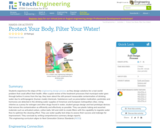
Students experience the steps of the engineering design process as they design solutions for a real-world problem that could affect their health. After a quick review of the treatment processes that municipal water goes through before it comes from the tap, they learn about the still-present measurable contamination of drinking water due to anthropogenic (human-made) chemicals. Substances such as prescription medication, pesticides and hormones are detected in the drinking water supplies of American and European metropolitan cities. Using chlorine as a proxy for estrogen and other drugs found in water, student groups design and test prototype devices that remove the contamination as efficiently and effectively as possible. They use plastic tubing and assorted materials such as activated carbon, cotton balls, felt and cloth to create filters with the capability to regulate water flow to optimize the cleaning effect. They use water quality test strips to assess their success and redesign for improvement. They conclude by writing comprehensive summary design reports.
- Subject:
- Applied Science
- Engineering
- Hydrology
- Physical Science
- Material Type:
- Activity/Lab
- Provider:
- TeachEngineering
- Provider Set:
- TeachEngineering
- Author:
- Jeanne Hubelbank
- Kristen Billiar
- Terri Camesano
- Timothy S. Vaillancourt
- Date Added:
- 10/14/2015